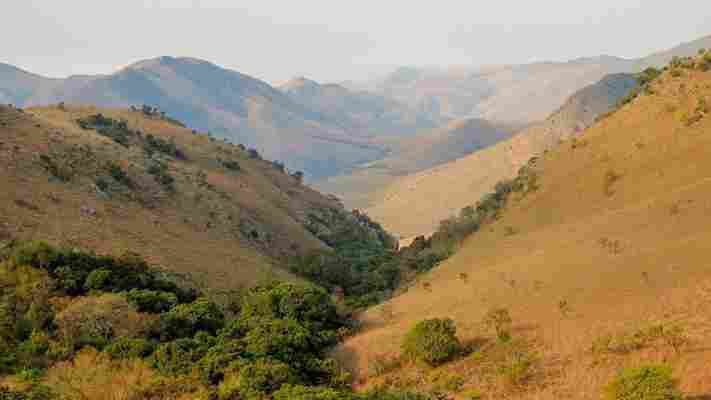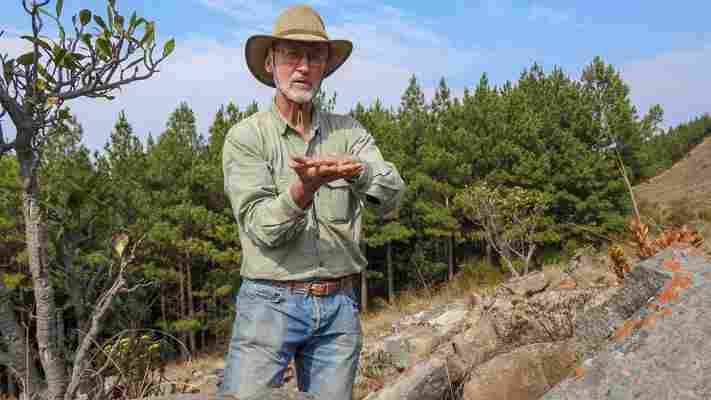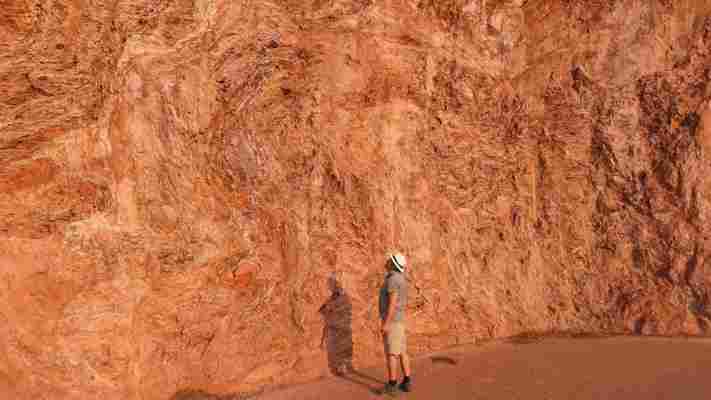Article continues below

South Africa's Makhonjwa Mountains date back 3.57 billion years
Between two-and-a-half and four billion years ago, during a time known as the Archaean Aeon, ash and debris from volcanic eruptions filled the Earth’s atmosphere and asteroids pummelled the oceanic planet. A dim-burning sun hung above the horizon and the Earth spun faster than it does today, causing shorter days. This is when Earth’s first continents were formed, creating shallow-water environments that allowed photosynthesis to take place. The Makhonjwa Mountains that rise behind the town of Barberton in South Africa’s Mpumalanga Province date back 3.57 billion years and were one of the first landmasses to rise out of the ocean. Recently declared the country’s newest [Unesco World Heritage Site](https://whc.unesco.org/en/list/1575), the mountains, also known as the Barberton Greenstone Belt, showcase some of the Earth’s oldest surface rocks. (Credit: Iga Motylska)

The Barberton-Makhonjwa Geotrail details Earth’s geological evolution
Opened in 2014, the 37km [Barberton-Makhonjwa Geotrail](https://geotrail.co.za/), which stretches from the outskirts of Barberton to the border of eSwatini (formerly Swaziland), winds its way through the Makhonjwa Mountains. Illustrated by colourful interpretative panels, the trail details Earth’s geological evolution and the first visible signs (to the naked eye) of living organisms, which have earned the region the name ‘The Genesis of Life’.Along with Tony Ferrar, a wildlife ecologist and experienced local guide, Professor Christoph Heubeck (pictured), a research scientist from Jena University in Germany, was part of the team responsible for planning the Geotrail. Together, they [authored and illustrated a guidebook](https://web.facebook.com/BarbertonGeotrail/posts/geotrail-guidebook-now-on-sale!/745083818854643/?_rdc=1&_rdr), available from the Barberton Tourism Office, which explains what scientists have learned from these rocks. (Credit: Iga Motylska)

The Banded Iron Formation is evidence of the creation of Earth's atmosphere
At the Banded Iron Formation layby, which is found 29km along the Geotrail, Heubeck and Ferrar asked me to imagine the hostile Archaean environment with its oxygen-free atmosphere. Around 3.25 billion years ago, photoferrotrophs (specialised single-celled bacteria) floated near the surface of the ocean, which was rich in iron. They used sunlight to split water and carbon dioxide to build their cells and reproduce, while excreting oxygen as waste. The oxygen combined with the dissolved iron to form iron oxide on the cell’s outer membrane. The Banded Iron Formations, with their rusty colour and visible iron oxide layered strata, are evidence of this process.“The cells became coated with rust and sank to the sea floor,” Ferrar said. “After hundreds of millions of years, all dissolved iron was removed from the oceans, and free oxygen, produced by these photosynthetic bacteria, could begin to accumulate in the atmosphere. This eventually produced oxygen-rich ecosystems that allowed multicellular life to evolve, and created the air we now breathe.” (Credit: Iga Motylska)
Gold was discovered in South Africa's Makhonjwa Mountains in 1884
Even before the first signs of visible life were discovered by scientists, settlers in the region discovered another treasure: gold. Though small pockets of gold were discovered in the region surrounding De Kaap Valley from as early as 1874, none were economically viable. It was only after brothers Henry and Fred Barber, who along with their cousin, Graham, discovered payable gold deposits in the Makhonjwa Mountains in 1884 that the region’s gold rush gained momentum.On 24 July 1884, David Wilson, the gold commissioner stationed 50km away at Kaapschehoop, named the town Barberton in their honour by breaking a bottle of gin – in the absence of Champagne – against what was to be called Barber Reef. News spread quickly, and gold prospectors from around the world journeyed to Barberton to seek their fortunes. (Credit: Iga Motylska)
Golden Quarry in South Africa is believed to be the world's richest gold mine
Legend has it that the amount of gold found in Golden Quarry (pictured), part of Sheba Mine near Barberton, was so large that miners had to extract rock from gold instead of the other way around. As we entered Golden Quarry, my guide Wynand Engelbrecht explained that this is believed to be the world’s richest gold mine in terms of gold deposits per ton of rock.Golden Quarry also holds the honour of being South Africa’s oldest mine still in operation. A wooden bridge stretches over exploration tunnels before entering the cavern that has been carved out with picks and shovels for more than 130 years. Engelbrecht picked up a rock and threw it down a shaft. It ricocheted against the walls until we could hear it no more. (Credit: Iga Motylska)
Eureka City, South Africa, was established after the discovery of the Sheba Reef
The town of Eureka City was established after the discovery of the Sheba Reef and the establishment of the Golden Quarry. At its peak, Eureka City was home to 700 residents, as well as shops, hotels, a music hall, two lawn tennis courts and the region’s first horse racing track. “At the height of Barberton’s gold rush in 1885, there were 28 pubs along the 20km stretch, known as the Golden Highway, between Barberton and the Victoria Hotel in Eureka City,” Engelbrecht told me. “Customers paid for a pint in one of two currencies: cash or gold.”But by 1924, Eureka City had been abandoned, as many gold prospectors left with the 1886 discovery of the precious metal 360km west of Barberton in what would later become the city of Johannesburg. Today, Eureka City is part of [Mountainlands Nature Reserve](http://www.mountainlands.co.za/) in the Makhonjwa Mountains and can only be visited on an organised tour in order to conserve its heritage. (Credit: Iga Motylska)
The most legendary person to visit Barberton was artist Conrad Frederick Genal
The gold rush attracted all types of characters to the Makhonjwa Mountains, from gold prospectors to writers to barmaids. But perhaps the most legendary person to set foot in Barberton was Conrad Frederick Genal, who was affectionately known as The Wandering Artist. The story goes that the 19-year-old German art student, who joined the French Foreign Legion in the 1890s, was shot in the buttocks by the ship’s guard when he deliberately jumped overboard in the Suez Canal in an attempt to desert his mission.Disguised as a trader, Genal walked south across the African continent, stopping for some time in Barberton before ending up in the South African coastal town of Durban, 650km south, where he died in 1939 at the age of 64. Throughout his journey, he made a living by painting friezes that were inspired by his journey on the walls of churches, hotels, town halls and private homes. Today, his friezes can be seen on the high-ceilinged walls of Barberton’s Transvaal Hotel (today the privately owned [Barberton History and Mining Museum](https://www.facebook.com/Barberton-History-and-Mining-Museum-749223285220802/)), as well as at the nearby [Diggers Retreat Hotel](https://www.facebook.com/Diggers-Retreat-Hotel-475729176118202/) and its Hanging Tree Bar. (Credit: Iga Motylska)
Barberton, South Africa’s riverbeds are still lined with gold
Barberton’s riverbeds are still lined with gold. Travellers can try their hand at gold panning in the South Kaap River. “A rounded rock on the riverbank is a good place to dig for gold as the water would have created a vortex, and gold, which is heavy, always sinks to the bottom and settles around the grass roots,” Engelbrecht told me, holding a trowel in one hand and a gold pan in the other.Engelbrecht scooped soil into the ribbed pan before flooding it with river water. He swirled it around to rinse out the mud and larger stones until the water was clear. Then he used the edge of his palm in a sweeping gesture to remove the topmost layer. He continued to do this until the finest granules remained, along with a tiny glint of gold. “When you see gold, you will know it. There’s something special about gold, it makes people go crazy,” he said. (Credit: Iga Motylska)
The Fountain Hotel and Baths was established in 1884 as a public bathhouse
The Fountain Hotel and Baths, situated on the slopes of the Makhonjwa Mountains, was established in 1884 as a public bathhouse for the hundreds of gold miners who descended on Barberton from around the world. It was the province’s first public swimming pool. The now-renamed [Fountain Baths Guest Cottages](http://fountainbaths.co.za/) has a swimming pool in the very same spot. Owners Esmari and Nick Harrod have a folder of newspaper clippings – some of which have been framed in the bar – that outline the guesthouse’s history. “Most of the newspaper clippings were collected by previous owners. Over the years, former guests, locals and those with family ties to Fountain Baths have also donated clippings,” said Esmari. “We are very fond of the place and have started a Fountain Baths timeline that illustrates how it has changed with time.” (Credit: Iga Motylska)
Leave a Comment